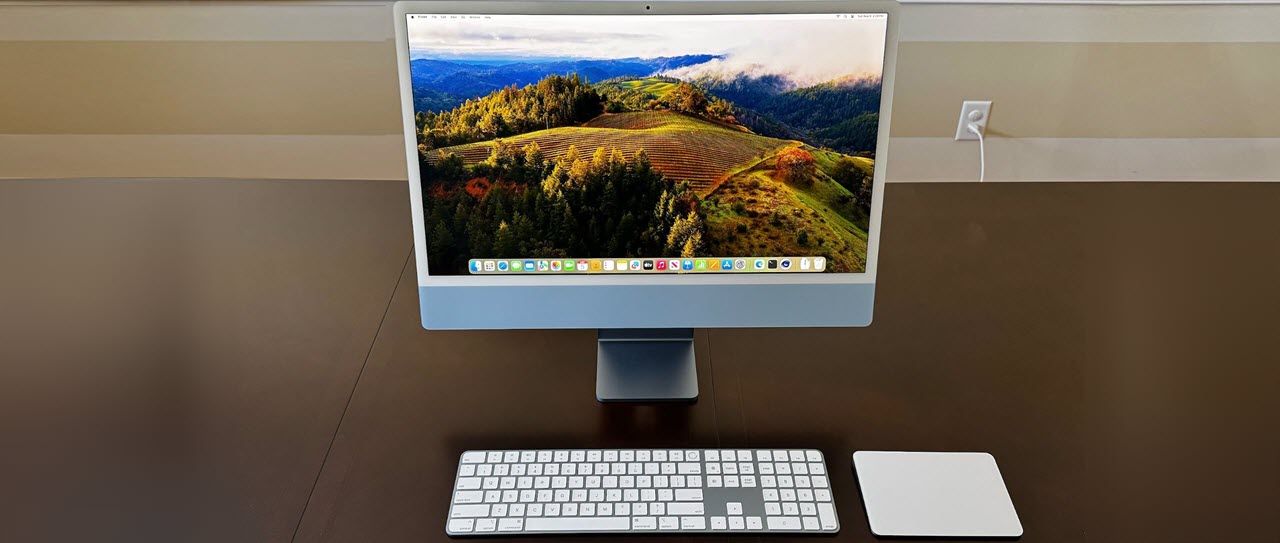Tom's Hardware Verdict
The iMac offers good overall performance for an entry-level system, but be wary of its quickly climbing price as you add RAM, storage, and ports.
Pros
- +
M3 delivers noticeable performance bump over M1 predecessor
- +
Attractive design available in many vibrant colors
- +
Excellent display
Cons
- -
Base config comes with 8GB of memory and 256GB of storage
- -
Memory and SSD upgrades are pricey
- -
Limited expansion ports
Why you can trust Tom's Hardware
Over two years ago, Apple launched an all-new iMac built around Apple Silicon. Apple had already made the switch with the MacBook Air, Mac Mini and 13-inch MacBook Pro, so it was logical that the iMac would also receive the power of the M1 processor.
As expected, the M1 brought serious gains in single- and multi-core performance over the Intel processors that it replaced, while being more efficient. The redesign also debuted a colorful new exterior, a magnetic power cord, and a bright 24-inch 4.5K (4480 x 2520) Retina display.
All seemed well, but Apple skipped the M2 upgrade for the iMac, even though the MacBook Air, Mac Mini, and 13-inch MacBook Pro all received the chip. Many wondered if Apple had forgotten its economical, all-in-one desktop. Well, wonder no more. A refreshed iMac is now upon us with an M3 inside and.... not much else in the way of changes. You still get the same chassis design, bright colors, display, and hardware limitations.
The iMac remains a good option for Mac users who want a no-frills desktop running macOS, but the system’s limitations, lack of upgradeability, and pricey upgrades remain frustrating.
Design of the iMac (2023)
The design of the iMac hasn’t changed from its initial 2021 redesign. The all-in-one is dominated by its 24.5-inch 4.5K (4480 x 2520) Retina display, surrounded by half-inch-thick white bezels. The top bezel is home to a 1080p FaceTime HD camera, while the bottom bezel transitions into a massive chin that is the same color as the iMac’s stand: light blue on our review unit. The stand is adjustable for tilt but isn’t height-adjustable, nor does it swivel. The back of the iMac is finished in a darker shade of blue, which provides a nice contrast.
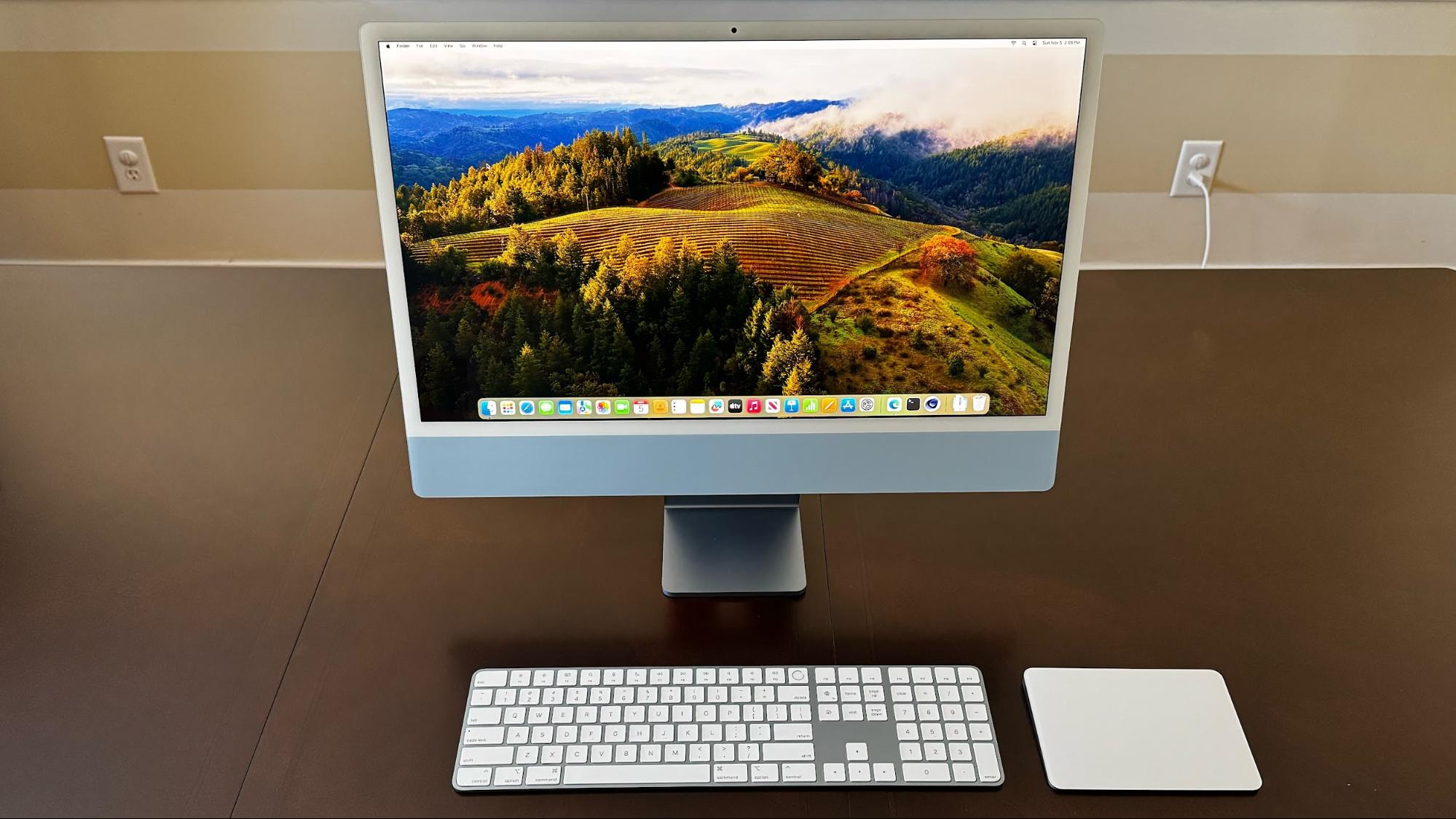
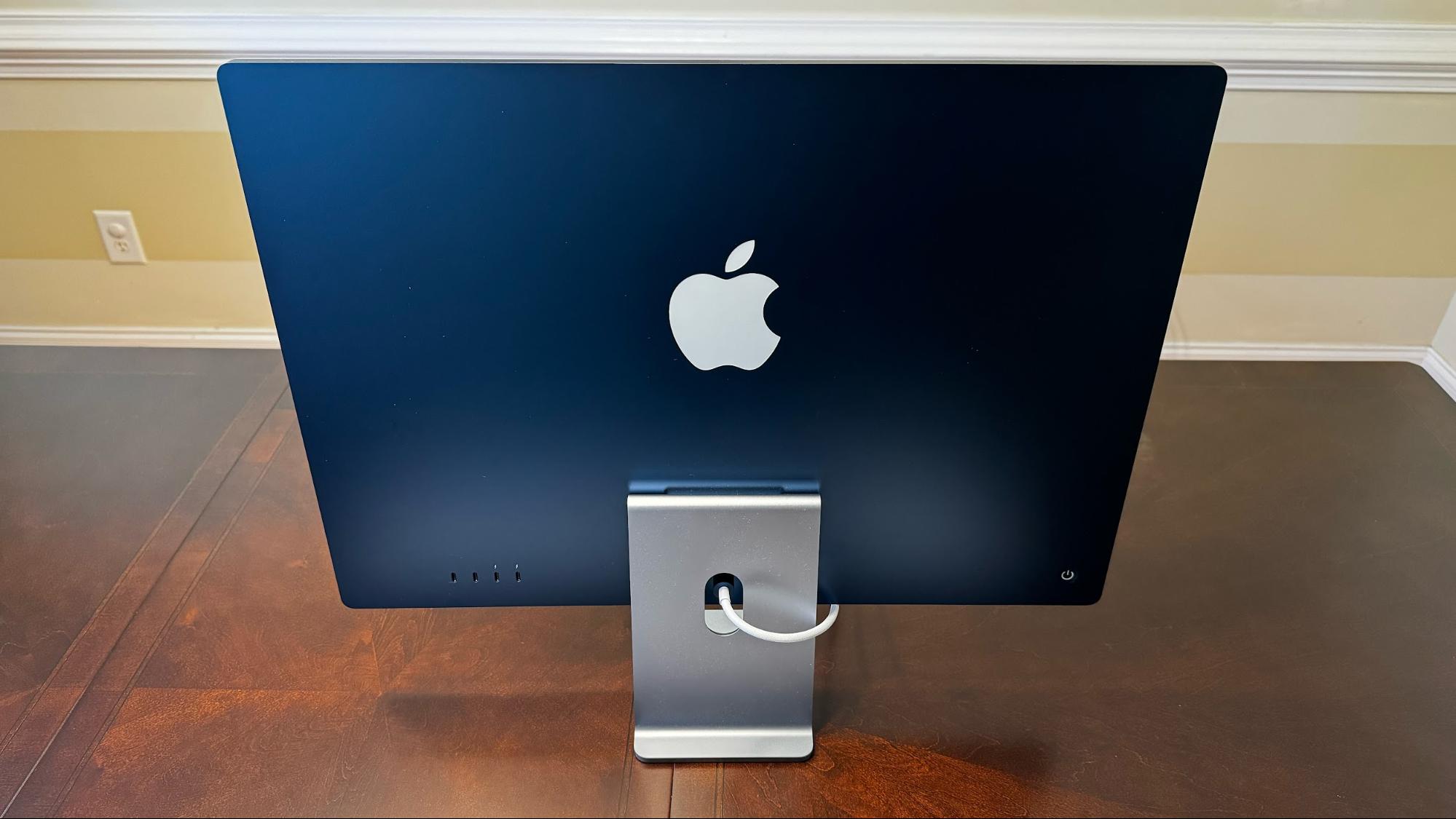

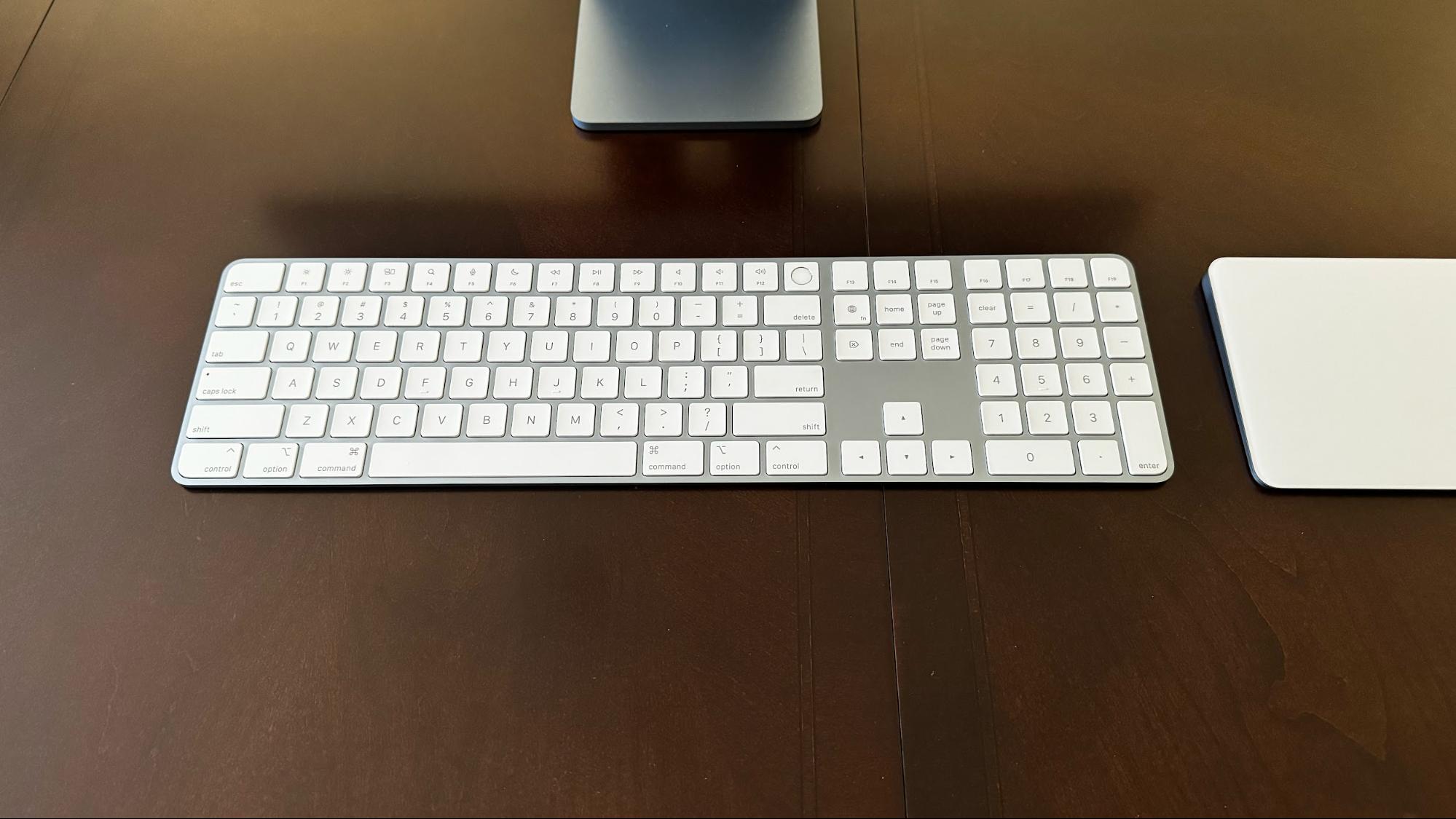

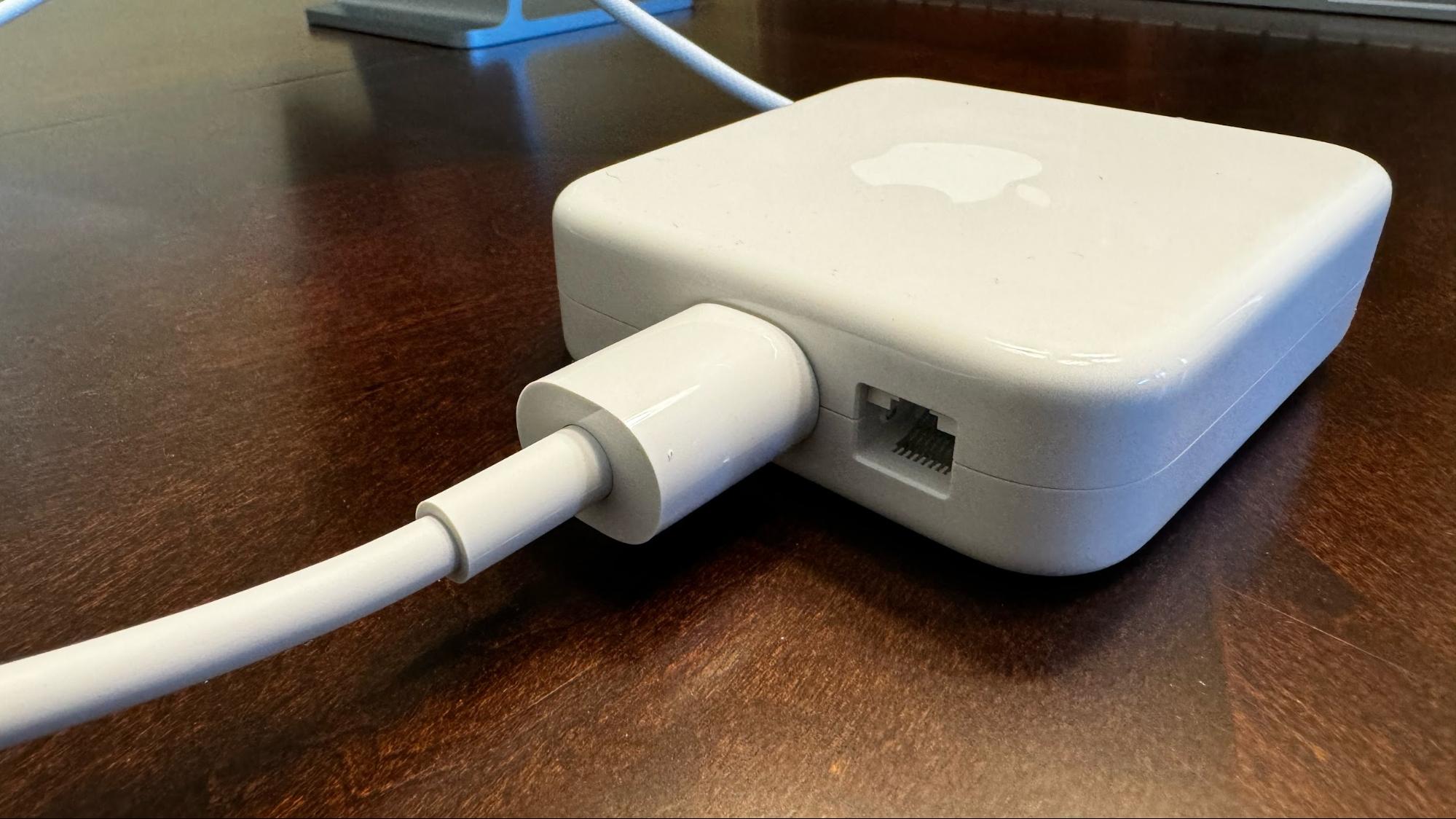
Ports are minimal on the iMac. There is a single 3.5mm headphone jack on the bottom-right side of the monitor. On the back, you’ll find the power button, two Thunderbolt 4 ports, and two USB 3 ports (10 Gbps). Base systems only come with two Thunderbolt 4 ports, which can be very confining for consumers unless you invest in a USB-C or Thunderbolt dock. There’s only one other port on the back of the iMac, a circular magnetic power port. Apple includes a hefty 143-watt power adapter with a color-matched braided cord to power the iMac.
In a nice twist, the power brick also features a Gigabit Ethernet port -- this arrangement allows you to have one less cable dangling from your desk. This feature is standard on our review unit configuration and optional on lesser models. We should also mention that the M3 chip only supports two displays, including the integrated 24.5-inch display. So you can only hook one additional monitor via USB-C or Thunderbolt 4 without using a DisplayLink solution. This is an artificial limitation put in place by Apple.
Get Tom's Hardware's best news and in-depth reviews, straight to your inbox.
Our iMac shipped with three wireless input devices: a Magic Keyboard with Touch ID and Numeric Keypad, a Magic Mouse, and a Magic Trackpad. All feature integrated batteries, which are recharged via a Lightning cable. Humorously, the Magic Mouse’s Lightning port is still on its underside, which remains one of Apple’s most baffling design choices that it refuses to change.
Another thing to note is that even though Apple is quickly shifting its devices and accessories to USB-C (including the new iPhone 15/15 Pro family and AirPods Pro), the accessories included with the iMac have yet to make this port switch. Maybe we’ll have to wait for the M4 iMac for that change to occur.
iMac (2023) Specifications
| CPU | Apple M3 (8-core CPU) |
| Graphics | 10-core GPU |
| Memory | 24GB unified memory |
| Storage | 2TB SSD |
| Display | 25.4inch 4.5K Retina Display, 4480 x 2520, 60 Hz |
| Networking | Wi-Fi 6E, Bluetooth 5.3 |
| Ports | 2x Thunderbolt 4 over USB Type-C, 2x USB-C, 3.5 mm headphone jack, Gigabit Ethernet |
| Camera | 1080p FaceTime HD camera |
| Power Adapter | 143 W |
| Operating System | macOS Sonoma |
| Dimensions (WxDxH) | 21.5 x 18.1 x 5.8 inches (547 mm x 461 mm x 147 mm) |
| Weight | 9.87 pounds (4.48 kg) |
| Price (as configured) | $2,858 |
iMac (2023) Performance
Our review unit came with an Apple M3 chip, which features an 8-core CPU (4 performance, 4 efficiency), a 10-core GPU, and a 16-core Neural Engine. It is also configured with 24GB of unified memory and a 2TB SSD.
We don’t typically review all-in-one machines, let alone iMacs, so finding a competitive set for it would be difficult. So instead of focusing on finding a desktop-equivalent match for the iMac, we will instead compare it to the M1 and M2 processors in the 13-inch MacBook Pro and 13-inch MacBook Air, respectively, to give an idea of how performance has improved compared to the original M1 iMac. All three generations of chips feature an 8-core CPU arrangement.
We first tested with the synthetic Geekbench 5 CPU benchmark, where the M3-equipped iMac delivered a single-core score of 2,235 and a multi-core score of 10,745. This was a 15 percent improvement in single-core performance and a 20 percent uplift compared to the 8-core MacBook Air with M2 processor. Of course, this was also a much stronger showing than the original M1 chip in the MacBook Pro that kicked off the Apple Silicon revolution.


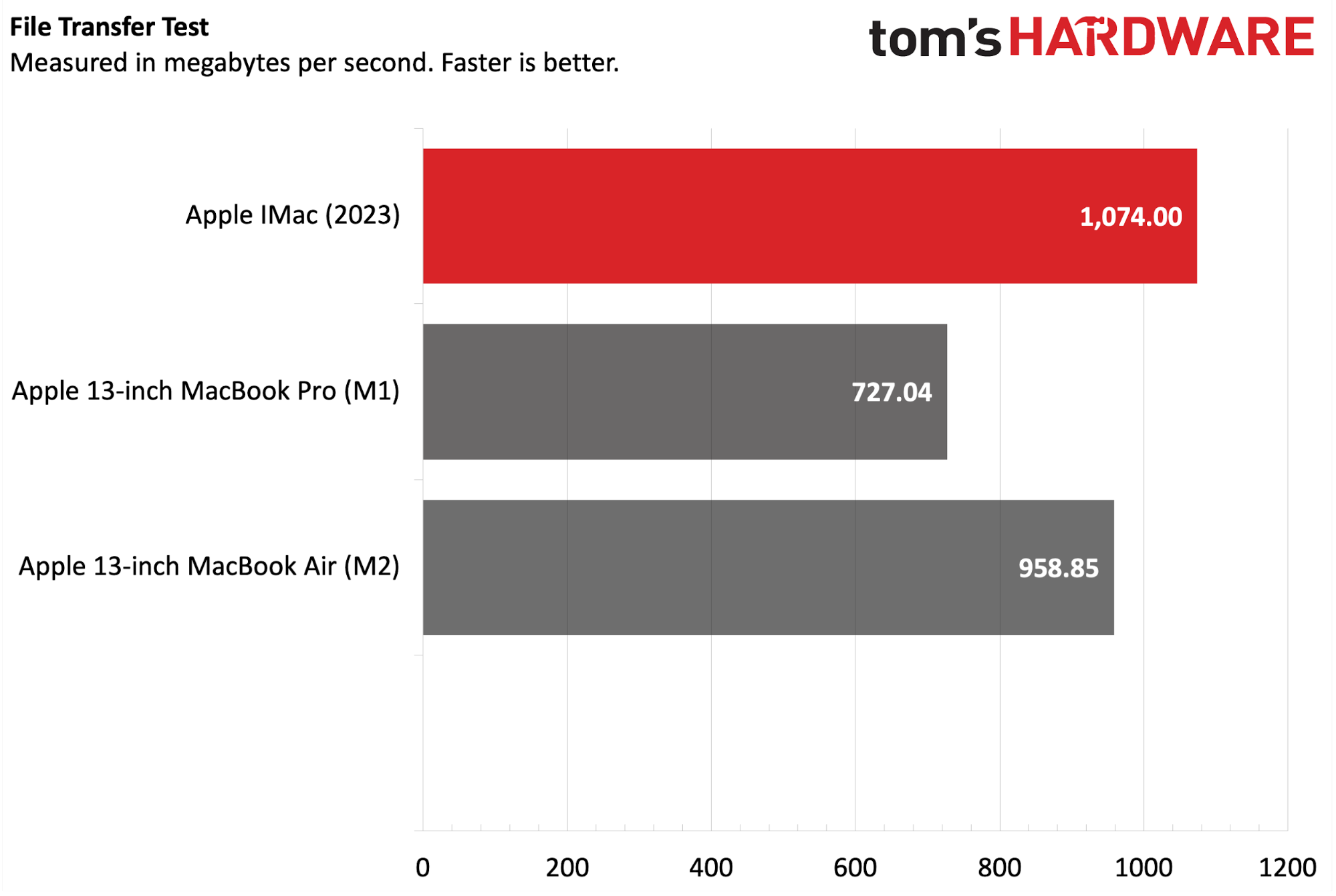
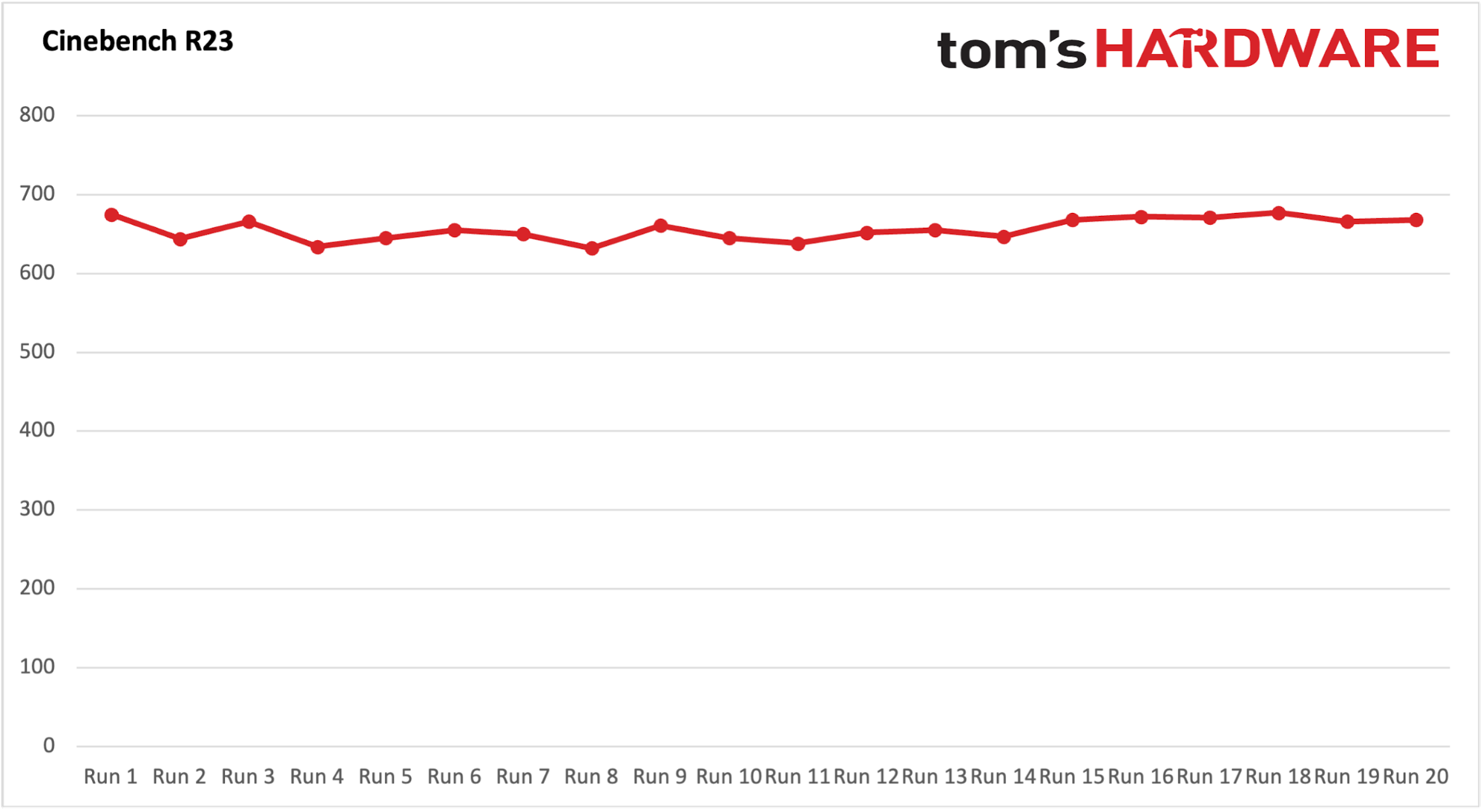
Moving on to Handbrake, where we transcode a 4K video file to 1080p, the iMac took six minutes and 46 seconds to finish the test. For comparison, the M1 and M2 machines were roughly a minute behind at 7:44 and 7:52, respectively.
We saw slight gains from the onboard 2TB SSD in our 25GB file transfer test. The test, which involves reading and writing on the same SSD, saw the iMac averaging 1,074 MBps compared to 958.85 MBps for the MacBook Air with M2.
The Xcode Benchmark is a relatively new test that we perform on Macs. The iMac finished in 153.249 seconds. For reference, a 16-inch MacBook Pro with an M3 Max can accomplish the same feat in 70 seconds.
We next turned our attention to Cinebench R24, a relatively new release of the benchmark suite with native support for the new M3 family of chips. Given that this is a new release, the results achieved with R24 aren’t directly comparable with R23. With that said, the iMac scored between 600 and 700 on the multi-core test. There were a few peaks and valleys during the first ten runs, but the scores started evening out as the 20th test concluded.
During the Cinebench R24 test, TG Pro recorded a system temperature of 50 degrees Celsius (122 degrees Fahrenheit) and a chip package temperature of 78 C (172.4). TG Pro doesn’t fully support the M3 chips currently, so I couldn’t measure the temperature of individual CPU cores (which is possible with M1 and M2 chips).
The iMac has never been considered as much of a gaming PC, even when it was equipped with Intel Core processors. It has always been an entry-level desktop, and that remains the case with its M3 upgrade. However, I did attempt to see how the 10-core GPU would handle a handful of games.
In Resident Evil Village, I set the resolution to 1920x1080, disabled HDR, and changed the graphics preset to “Balanced.” With these settings, the game used 4.17GB of 14.01GB memory available. I average between 52 frames per second and 74 fps, depending on if I was outside or inside in the game. Things didn’t go so smoothly at 1080p in Shadow of the Tomb Raider (Highest), where we averaged 34 fps. Borderlands 3 (Badass) turned in a dismal 21.45 fps at 1080p.
Throughout all testing, the iMac stayed remarkably quiet. I barely heard any fan noise, but did feel the steady stream of warm air pouring out from the air vents under the massive chin.
Display on the iMac (2023)
The iMac features a 24.5-inch 4480 x 2520 (4.5K) Retina display. This is an IPS panel with a 60Hz refresh rate and a glossy screen coating. I must admit that the white bezels around the display looked odd to me at first. I’m used to black bezels on almost all my computing devices, so Apple’s peculiar design choice truly stands out.
With that said, our colorimeter registered 76.8 percent coverage of DCI-P3 and 108.2 percent coverage of sRGB. In addition, the maximum brightness for the display came in at 479.8 nits, a bit shy of the 500 nits claim from Apple.
As with MacBooks, the iMac has Apple True Tone enabled by default. The feature adjusts the colors on the display to match your current environment. In most cases, the colors skewed warmer with True Tone enabled. If you prefer more accurate colors, you can simply turn off the setting. I disabled it, as I prefer the non-adjusted colors over what Apple “thinks” would be more appealing to my eyes.
I binged a few episodes of Star Wars: Ahsoka on Disney Plus and watched the movie Collateral on Plex. Colors looked good in Ahsoka and Collateral, but I noticed that blacks looked more like muddy dark grey in the latter. Collateral is set entirely at night, so the subtle backlight bleed was inescapable.
Webcam and Speakers on the iMac (2023)
The iMac uses a 1080p FaceTime HD camera, and its image quality is similar to the most recent MacBooks and MacBook Pros. That means that colors are accurate, detail is sharp, and skin tones are accurately rendered. However, for even better image quality, you can use the Continuity Camera function to use a connected iPhone as your webcam. With the iPhone’s main camera sensor at your disposal, overall image quality sees a substantial boost, but it’s overkill for videoconferencing over Google Meet or Zoom.
As for the audio system, the iMac uses a six-speaker setup with force-cancelling woofers. The speakers support Apple Spatial Audio and Dolby Atmos. Gunfire came in loud and clear, with no distortion at nearly 100 percent volume while watching Collateral. I also queued up “Futures” by Zero 7 and was immediately calmed by the vocals of Jose Gonzalez. An acoustic guitar, drums, and a piano back the mellow track. Again, the music poured through the speakers with zero distortion, filling my home office.
Upgradeability on the iMac (2023)
What you see is what you get with the iMac. There is no upgrading this machine once it ships from Apple. There are also no obvious ways of getting inside the system (i.e., with pentalobe screws). So even if you wanted to get inside, you’d have to break out a heat gun and a suction cup to remove the display and dive in.
The lack of user-initiated hardware upgrades has long been a sticking point with Apple, especially since memory and storage upgrades are so pricey for its systems. Although we wish that Apple would reverse course and at least provide easy access to standardized M.2 SSD upgrades, that ship has sailed.
iMac (2023) Software and Warranty
The iMac comes preinstalled with macOS Sonoma (Version 14.1). Sonoma brings new features like Game Mode, which prioritizes the CPU and GPU to boost gaming performance and reduces latency for wireless accessories. Widgets can be placed on the desktop (including ones synced from your iPhone), and Private Browsing now has better security. There are dozens of other minor additions and tweaks, which you can read about here.
Every Mac comes bundled with many Apple apps like Mail, Messages, Photos, Safari, and Maps. These apps sync across your iOS/iPadOS devices and other Macs signed in to your iCloud account. Apple also provides its free productivity suite, which includes Numbers, Pages, and Keynote.
iMac (2023) Configurations
Our iMac review unit came configured with an 8-core M3 CPU, 10-core GPU, 24GB of unified memory, a 2TB SSD, 143-watt power adapter with Gigabit Ethernet, Magic Mouse, Magic Trackpad and Magic Keyboard with Touch ID and Numeric Keypad. The total for this top-of-the-line system is $2,858, or more than twice the base system price of $1,299.
The $1,299 configuration gets you an 8-core M3 CPU, 8-core GPU, 8GB of unified memory, and 256GB of storage. Yes, you read that right – 8GB of RAM. Granted, 8GB of memory seems to go a lot further in macOS than it does in Windows 11, but that is still a woefully small amount of memory for a system priced north of $1,000. The 256GB of storage is also rather stingy; it’d be nice if Apple would at least double that amount.
The paltry base memory/storage options are compounded by the expensive upgrades that Apple offers. Adding another 8GB of memory to get to 16GB costs $200. If you want 24GB of memory, that will cost you $400. Want to double the 256GB SSD to 512GB? That’s another $200, while going with 1TB on the base system costs $400 extra.
Oh, and the optional Gigabit Ethernet we mentioned earlier is a $30 upcharge. It feels like Apple is nickel and diming customers to death, pushing them into pricier tiers to get an acceptable amount of memory, storage, and even ports.
All iMacs feature a 24-inch 4.5K display, 1080p FaceTime HD camera, 6-speaker audio, Wi-Fi 6E, and Bluetooth 5.3. The machine is available in Blue, Green, Pink or Silver in the base $1,299 config. All other models are available in Blue, Green, Pink, Silver, Yellow, Orange or Purple.
Bottom Line
The iMac has always been a reasonably economical system for Mac users who want “just the basics” in an everyday computer. The screen is large, bright, and colorful. The minimalist design blends in with just about any décor (and you can choose from various colors to match), and the new Apple M3 chip provides a big jump in performance compared to the M1 model that debuted in 2021.
Unfortunately, there are quite a few “gotchas” here. While the $1,299 starting price is enticing, you’re saddled with just 8GB of unified memory and a 256GB SSD. That’s hardly enough to futureproof the iMac. A simple upgrade to 16GB of memory costs a staggering $200, while storage upgrades are equally pricey.
If you want Gigabit Ethernet, that’s a $30 upcharge, and you only get two Thunderbolt 4 ports on base systems. You must spend at least $1,499 to get two Thunderbolt 4 ports and two USB 3 ports.
Apple’s iMac is an excellent all-in-one macOS machine, though it's in need of a rethink when it comes to its pricing and available configurations.

Brandon Hill is a senior editor at Tom's Hardware. He has written about PC and Mac tech since the late 1990s with bylines at AnandTech, DailyTech, and Hot Hardware. When he is not consuming copious amounts of tech news, he can be found enjoying the NC mountains or the beach with his wife and two sons.
